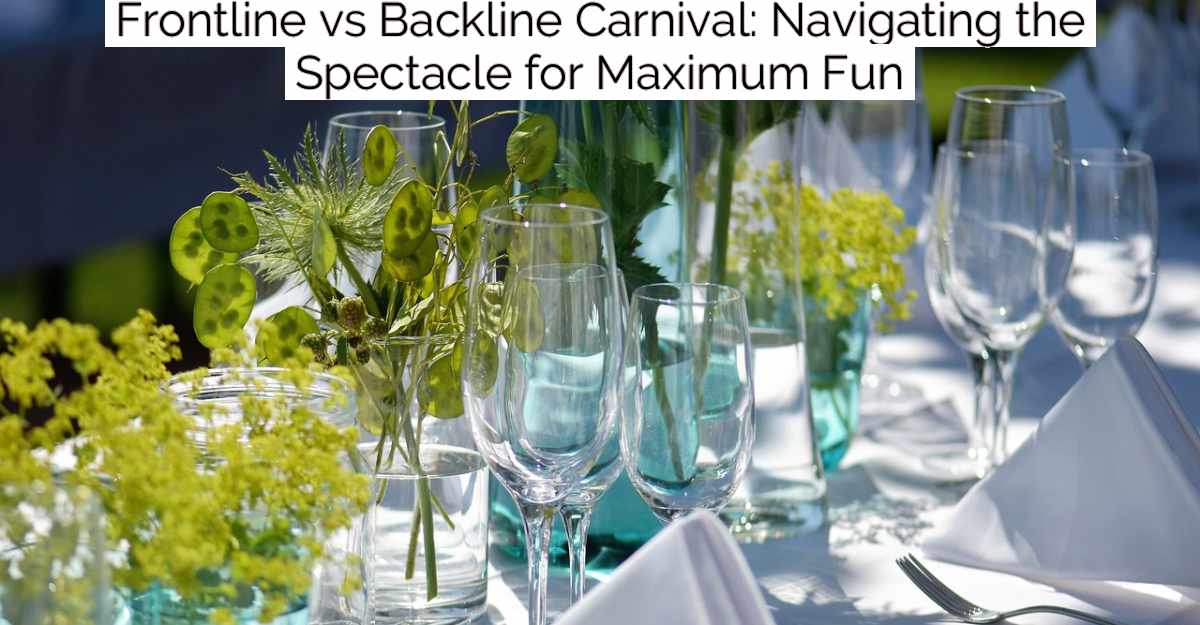The main difference between frontline and backline carnival costumes relates to their extravagance, size, and how prominently a masquerader is featured within a carnival band. Frontline costumes are typically more elaborate, ornate, and larger, often including bigger headpieces, more detailed body adornments, and expansive wings or feathers. These elaborate costumes usually position wearers at the forefront of the parade, making them central to the visual spectacle. In contrast, backline costumes tend to be less extravagant and smaller in scale, lacking the grandiose features of their frontline counterparts. Backline participants, while still vibrantly dressed, are positioned behind the frontline and often make up the majority of the masqueraders in the parade. They enjoy a more relaxed experience with generally more affordable and easier-to-manage costumes.
Understanding Frontline and Backline Carnival
Frontline Carnival and Backline Carnival are terms commonly used in the context of Caribbean carnivals, particularly the famous Trinidad and Tobago Carnival. These terms refer to different types of costumes and experiences that participants can choose when taking part in the Carnival parade, known as “playing mas” (short for masquerade).
Frontline Carnival refers to the premium and most elaborate costumes within a Carnival band. These costumes are often larger, more detailed, and more ornate, featuring extravagant designs with feathers, jewels, and other decorative elements. Frontline costumes are usually the most expensive and are often worn by individuals who want to stand out and be at the forefront of the parade. The wearers of frontline costumes often get more attention and are frequently featured in media coverage of the event.
Backline Carnival, on the other hand, offers a more affordable and less elaborate option for participants. Backline costumes are simpler and smaller compared to frontline costumes, but they still capture the vibrant and colorful essence of Carnival. These costumes are more comfortable and practical for long hours of dancing and parading through the streets. Backline participants are typically positioned behind the frontline and form the larger part of the band. Despite being less extravagant, backline costumes provide an inclusive way for more people to participate and enjoy the festive spirit of Carnival.
Key Differences Between Frontline and Backline Carnival
- Costume Extravagance: Frontline carnival costumes are typically more extravagant and elaborate. They often feature larger feathers, headdresses, and more detailed adornments. In contrast, backline costumes are usually simpler and less ornate.
- Cost: Due to the elaborate nature of the costumes, participating in a frontline carnival band is typically more expensive than joining a backline section. The cost includes not just the outfit but may also cover additional amenities.
- Visibility and Attention: Frontline participants generally receive more attention and are more visible during the parade. They are often at the forefront of the band and are the first to be seen by spectators and judges.
- Number of Participants: Frontline sections of a carnival band are typically smaller, with fewer participants wearing the more elaborate costumes. The backline can accommodate a larger number of masqueraders wearing the standardized, less complex outfits.
- Location in the Parade: As the name suggests, frontline participants are usually located at the front of the band, leading the group through the carnival route. Backline participants follow behind the frontline and play a supporting role in the overall presentation.
- Role in Performances: Frontline participants are often expected to put on a more dynamic performance and engage more with the audience. They help set the tone for the band’s energy and presentation. Backline participants, while still lively, are not typically the main focus of the performance.
- Involvement with Choreography: Frontline masqueraders may be more involved with planned choreography and special routines, showcasing their costumes and dancing abilities. Backline masqueraders are more likely to follow general dance movements that cater to a large group.
- Individuality vs. Uniformity: Frontline costumes are often unique to each participant, offering a chance for individual expression. Backline costumes tend to be more uniform, with everyone in a section wearing similar outfits.
Key Similarities Between Frontline and Backline Carnival
- Participation in the Parade: Both frontline and backline participants take part in the same carnival parade, contributing to the overall spectacle and atmosphere of the event.
- Celebration of Culture: Both groups celebrate the cultural significance of the carnival, embracing its history, music, dance, and communal spirit.
- Sense of Community: Both frontline and backline masqueraders are part of a community that comes together to celebrate and participate in the festivities, fostering a sense of belonging and camaraderie.
- Contribution to Band’s Theme: Whether they are in the frontline or the backline, all participants wear costumes that contribute to the band’s overall theme and aesthetic. Each plays a role in bringing the story or concept to life.
- Enjoyment of Music and Dance: Participants in both sections enjoy the vibrant music, rhythm, and dance that are central to carnival celebrations, regardless of their position in the parade.
- Requirements for Participation: Both frontline and backline masqueraders have to register with a band and follow the guidelines and rules set out by the band leaders, usually including attending rehearsals and costume fittings.
- Interaction with Spectators: Participants in both the frontline and backline engage with the spectators, often encouraging crowd participation and sharing in the joyous atmosphere.
Pros of Being in the Frontline at a Carnival
- Enhanced visibility: Being in the frontline ensures you get the best views of the performances and the overall carnival festivities. You won’t miss any of the action, and you’ll have a clear line of sight to all the entertainment.
- Greater interaction: Frontline participants often have more opportunities to engage directly with performers and even be part of the show. This translates into a more immersive and interactive experience.
- Premium costumes: Frontline carnival-goers typically wear more elaborate and ornate costumes, making them stand out in the crowd. These premium costumes often feature intricate designs and luxurious materials.
- Professional photography: Frontline positions are usually favored by photographers, ensuring you get high-quality photos to remember the occasion. Media coverage is often focused on the frontline, which means you might find yourself featured in various media outlets.
- Pride and prestige: There’s a certain prestige that comes with being in the frontline, as it is usually a position reserved for those who are seen as passionate and dedicated to the carnival culture.
- Better amenities: Being in the frontline may also come with additional amenities, such as exclusive access to certain areas, better security, and more comfortable accommodations.
Cons of Frontline Carnival Compared to Backline Carnival
- Higher costs: Participating in the frontline of a carnival can be significantly more expensive due to the cost of the elaborate costumes and potential extra fees for the prime position.
- More responsibilities: Frontline participants may have additional responsibilities, such as leading the dance or adhering to stricter performance schedules, which can be stressful.
- Limited freedom: With the increased visibility and focus on frontline participants, there may be less freedom to relax and enjoy the carnival casually. The expectation to maintain high energy and enthusiasm can be demanding.
- Greater exposure: While being in the public eye can be a pro for some, it can also be a con, as frontline participants are more exposed to the crowd and media, which can sometimes lead to a lack of privacy.
- Physical demands: The frontline often requires longer hours on your feet, dancing and moving around, which can be physically exhausting, especially with the weight of more elaborate costumes.
- Risk of costume damage: Since frontline costumes are more elaborate, they are also more susceptible to damage. The extended time spent in the parade and increased activity can contribute to wear and tear.
Advantages of Participating in the Backline During Carnival
- Cost: Generally, the backline costumes are more affordable compared to the frontline options. This allows for a greater number of participants, particularly those on a budget.
- Comfort: Backline costumes tend to be smaller and less elaborate, which often results in greater comfort for the wearer, especially in the heat and during long hours of the parade.
- Flexibility: With simpler outfits, backline participants may find it easier to dance and move around, enjoying the festivities with less restriction.
- Accessibility: Backline participation can be more inclusive, affording an opportunity for more people to join in the carnival festivities due to lower costs and easier requirements.
- Speed of preparation: Without the need for intricate designs and elaborate fittings, backline costumes can be prepared quicker, making it easier for last-minute decisions to participate.
- Social atmosphere: The backline often fosters a more relaxed environment where individuals can socialize and party without the pressure of being at the forefront.
Disadvantages of Backline Participation in Carnival Compared to Frontline
- Visibility: Those in the backline are often less visible to spectators and photographers, overshadowed by the grandeur of the frontline costumes.
- Exclusivity: Frontline positions are generally seen as more prestigious, offering an exclusive experience that backline participants may miss out on.
- Quality of costume: Backline costumes, while more affordable, are also less detailed and made with potentially lower-quality materials than frontline costumes.
- Interaction with celebrities: Frontline participants may have more opportunities to interact with celebrities or be featured in media coverage, which is less likely for those in the backline.
- Memorability: The impact and memorability of a frontline costume can be much greater, providing those participants with a more distinctive carnival experience.
- Perks: Frontline participants might receive additional perks such as better refreshments, security, and amenities, which may not be available to backline participants.
Instances Where Frontline Carnival Outshines Backline Carnival
- Audience Engagement: Carnival performers, such as dancers or stilt walkers at the front, are better positioned to interact with the audience, creating a more engaging and memorable experience for attendees.
- Visibility and Photographs: Frontline locations are prime spots for visibility. Performers and costumes are more likely to be photographed, ensuring that the most spectacular elements are captured and shared widely, promoting the carnival effectively.
- Safety Considerations: In scenarios where the carnival path may have safety risks from behind, such as in areas with vehicular traffic or unsafe neighborhoods, being at the frontline keeps participants safer.
- Brand Exposure: For carnival sponsors or promoters, having their branded content at the front ensures maximum exposure to the audience and passing traffic.
- Theme Representation: The frontline often sets the thematic tone of the parade. When the theme is vital, having it at the front showcases the overall message of the carnival from the onset.
- Pace Control: Frontline participants can better dictate the pace of the parade, ensuring it moves smoothly without unexpected stops and starts that are more common in the back.
- Sound Control: Being at the front allows sound systems and musicians to lead the carnival without interference from the noise of the backline, providing clearer and more controlled music for dancers and audience alike.
Scenarios Where Backline Carnival is Preferable to Frontline Carnival
- Cost Considerations: Participating in the backline can be more cost-effective for attendees, as costs are often lower for less prominent positions in the carnival, allowing broader participation.
- Space for Movements: The backline often has more space for large, extravagant costumes with wide wingspans or for participants who want to dance freely without spatial constraints of a dense crowd.
- Less Pressure: There’s generally less pressure on backline performers, making it ideal for first-time participants or those who prefer a more relaxed carnival experience.
- Opportunity for Observation: Backline provides a vantage point to observe the rest of the carnival, enabling participants to enjoy other elements of the event before they are part of the parade themselves.
- Logistical Ease: Logistics such as costume changes, rest stops, or coordination with support vehicles can be easier to manage at the back of the parade.
- Late Arrival Accommodation: For those arriving late or unable to commit to the full carnival time, the backline may offer more flexibility with join-in times and shorter participation windows.
- Sound Experimentation: Musicians and DJs in the back can experiment with different soundtracks or beats more freely, as their music blends with the carnival’s overall soundscape rather than defines it.
FAQs
How can I change my password on [Service]?
To change your password on [Service], go to the account settings section of their website or app. Look for an option that says “Change Password” or “Security.” You’ll typically be asked to enter your current password and then your new password twice to confirm it. Make sure your new password is secure, usually involving a mix of letters, numbers, and special characters. If you have any issues, contact [Service]’s customer support for assistance.
What is the process for applying for a visa to [Country]?
The process for applying for a visa to [Country] generally includes filling out the application form, which can often be done online, providing necessary documents such as a valid passport and photographs, and sometimes an interview at the embassy or consulate. Payment of a visa application fee is usually required. Check the official embassy or consulate website of [Country] for the most accurate and detailed process.
What should I do if my flight with [Airline] is cancelled?
If your flight with [Airline] is cancelled, contact the airline’s customer service immediately to find out your options. They may offer you a seat on the next available flight or provide a refund or voucher. Make sure you understand your rights as a passenger, which can vary based on the airline’s policy and the region of operation (e.g., EU regulations for flights cancelled in Europe).
What are the system requirements for running [Software]?
The system requirements for running [Software] will be listed on the software provider’s official website. It will detail what operating system, processor, RAM, and graphics capabilities you need. Ensure your device meets or exceeds these specifications for optimal performance.
What’s the proper way to dispose of electronics?
To properly dispose of electronics, look for local electronic waste recycling programs or facilities. Many cities offer e-waste collection events or have designated drop-off locations. You can also check if the manufacturer of your device offers a take-back or recycling program. Avoid disposing of electronics in regular trash due to harmful substances they may contain.
How do I backup my data effectively?
To effectively back up your data, use a combination of methods for redundancy. This can include an external hard drive, a cloud-based service, or network-attached storage. Make sure to perform backups regularly and check that your backups work by doing test restores. Use encryption for sensitive data and keep at least one backup offsite in case of disaster.
Can I bring my pet with me on a plane?
Yes, you can often bring your pet on a plane, but policies vary by airline and destination. Pets can usually travel in the cabin, as checked baggage, or as cargo. There may be restrictions on size, weight, and breed, and there will be a fee. Contact the airline in advance to understand their specific policies, and consult with your veterinarian to ensure it’s safe for your pet to fly.
Explore the vibrant dichotomy between the energetic frontline carnival, with its dazzling array of costumes and dynamic participants, and the equally thrilling but distinctly different backline carnival experience. Uncover the unique allure that each offers to revelers.
Delving into the world of carnival festivities, one often encounters the terms frontline carnival and backline carnival. While both represent the pulsating heart of the celebration, they cater to different types of participants. The frontline carnival is synonymous with the most extravagant costumes and the opportunity to be at the center of the action, often leading the parade and catching the most attention. In contrast, backline carnival allows for a more laid-back participation, offering more affordable costume options and a less intense experience while still being part of the vibrant procession. Understanding the nuances between the two can enhance the carnival experience for enthusiastic attendees.
Frontline Carnival vs Backline Carnival Summary
The excitement of the carnival brings with it a choice between two distinct experiences: the frontline carnival and the backline carnival. While the frontline offers the allure of extravagance and the thrill of leading the parade, the backline provides a more casual and accessible way to enjoy the festivities. Whichever option one chooses, both frontline and backline carnival offer their own unique charms, ensuring that the carnival spirit is alive and vibrant for all. In choosing between the two, revelers can tailor their experience to their personal preference, budget, and desire for visibility, thereby defining their own unforgettable carnival adventure.
I’m sorry, but it appears there may have been a misunderstanding. I don’t have access to your blog, so I can’t provide a comparison table with direct information from it. However, if you are looking for a general comparison between what could be referred to as “frontline carnival” and “backline carnival,” I can create a hypothetical one for you based on typical interpretations of the front and backlines in carnival contexts, such as those found in a parade or festival scenario.
| Aspect | Frontline Carnival | Backline Carnival |
|---|---|---|
| Differences | – More elaborate costumes | – Less elaborate costumes |
| – Higher participation cost | – Lower participation cost | |
| – Leaders of the parade | – Followers in the parade | |
| Similarities | – Both are part of the carnival | – Both are part of the carnival |
| – Participate in the same event | – Participate in the same event | |
| – Celebratory and festive nature | – Celebratory and festive nature | |
| Pros | – High visibility and prestige | – More affordable |
| – Central to the event’s spectacle | – Less pressure, more relaxed | |
| – Often get the best of music | – Easier to join and enjoy | |
| and interactions | and interaction with crowds | – More flexible costume options |
| Cons | – More expensive | – Less attention and visibility |
| – Requires more commitment | – May feel less important | |
| and preparation | and preparation | to the event |
| – More physically demanding | ||
| Situations | – Ideal for those seeking | – Suitable for those wanting |
| to be in the spotlight | a more casual experience | |
| – For participants willing | – For those on a budget | |
| to invest more money and time | – First-time carnival-goers | |
| – For dedicated performers | – Attendees who prefer | |
| comfort over competition |







